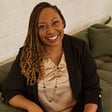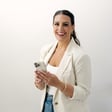The Pitfalls of Serial Rebranding
00:00:05
Speaker
I call those serial rebranders people who once a year you can count on them to take advantage of a Black Friday sale, new websites because whatever they bought last year doesn't fit anymore and it's because the brand identity at its core has never been addressed and never been defined and they're expecting to put on a cute outfit and for that to solve their brand identity problems but it doesn't.
Introduction to Brand Building Podcast
00:00:29
Speaker
Welcome to the Brands at Book Show, where we help creative service-based businesses build their brands and find more clients. I'm your host, Davy Jones.
00:00:41
Speaker
Abby Grace returns to the Brands That Book podcast to discuss creating a brand identity.
Six Key Aspects of Brand Identity
00:00:46
Speaker
And just like her first Brands That Book interview, this episode is full of insightful and practical advice. We discuss at length six aspects that Abby believes creates a robust brand identity. How new businesses or businesses that have never gone through a brand experience can start crafting a brand identity and the approach businesses should take with their visuals before or as they are going through that discovery process.
00:01:10
Speaker
If you don't know Abby, she's an international brand and wedding photographer based just out of Washington DC.
Crafting Your Brand Identity
00:01:16
Speaker
And I would encourage you to go back and listen to the previous Brancett book episode she was on. She was on as a guest on episode 30 where she shared about the gentle no. Again, full of great practical advice. So consider going back and listening to that one after you listen to this episode.
00:01:32
Speaker
Be sure to check out the show notes at DavyandChrista.com for the resources we mentioned during the episode, and I want to hear from you. Let me know what kind of content you'd like to see on the Brands of the Book podcast as we move forward, especially as we tackle our next 100 episodes. To leave your feedback, just send us a DM on Instagram, at DavyandChrista. Now, onto the episode.
00:01:56
Speaker
But I was so happy when you reached out because first of all, I think every time I've heard you speak, and certainly this is true of the last episode we recorded. So if you haven't listened to the first episode, after you're done listening to this one, you should head back and listen to that one as well.
Abby's Personal Journey & Business Transition
00:02:09
Speaker
You just pack your presentations with so much actionable content. So I'm really excited to dig in what you have today about brand identity. And you know, today I was looking, we're using Skype to record and I was looking on Skype and it said last chatted over a year ago.
00:02:24
Speaker
Yeah, I think it was December 2018. Yeah, it's like it can't have been that long. But here it is. So a lot has happened since then. I mean, heck, a lot has happened just in 2020 here. But what has been going on with you since the last time we chatted? Yeah, so we've had a couple big transitions. I mean, the first and most glaring and most joyful is that my husband Matt and I became parents. We adopted our son Felix
00:02:49
Speaker
a year ago. So he's, he turned one last week, which has just been banana pancakes and like the most beautiful ride. So that's just like a constant source of joy. We're also a lot more tired than usual, but you know, for the best reason, best reason possible.
Launching Branding Photography Service
00:03:05
Speaker
But from like a business perspective, we, so we officially transitioned into offering branding photography last, so it would have been like probably six months after you and I talked. So it was last May.
00:03:16
Speaker
And I've been shooting branding photographs since 2016. Actually, Natalie Frank was my first branding client ever. And it was one of those things that was like a slow build that like forced itself onto my radar. And I actually really, really love. And so last May we realized, wow, we're getting a lot more inquiries for this. I'm really good at this. Let's make this an official part of our offerings. And so we launched that last May and it's taken off in a really
Visuals vs Core Brand Identity
00:03:41
Speaker
cool way. I've had the opportunity to shoot for
00:03:43
Speaker
some of the most incredible names
00:03:55
Speaker
And just an incredible insight into branding, not just a photography side, but like brand identity in general. So it's given me an idea because you know, it's so hard to remember where you were at the beginning of your career. Like, what was I struggling with? Or like, what were my pain points? And so there's some of the inquiries that we receive and the business owners that I've been talking to. I'm like, Oh my gosh.
00:04:15
Speaker
There's this huge glaring void of information on brand identity. You know, we talk about branding in general a lot like, oh, I need a new logo or color palettes or whatever. And so we talk a lot about the brand visuals, but the concept of brand identity is one that so many people are missing, but they don't even realize it. And so having a front seat to that, it's given me just this fire to help new business owners like unearth what their brand identity is. People don't even know. They don't know it. It's that unconscious incompetence.
00:04:44
Speaker
part of the learning cycle and so we love sort of turning the light on and being like here's what you're missing and here's the questions that you should be asking.
Consistency in Brand Messaging
00:04:51
Speaker
We launched a branding course, branding foundations a couple months ago to tackle this very issue and it's something I'm talking faster I'm excited like it's something I love love talking about because I think it can shed such freedom for business owners who are struggling with something that's missing but they don't know what it is yet.
00:05:07
Speaker
Yeah, I think I've told this before but another thing that I really enjoy about watching you present is that you get excited about things and you talk pretty quickly and it's just so engaging to listen to. I tend to talk pretty quickly as well and people sometimes come up and be like, you really need to slow it down. I'm like, I can't, I'm not going to. You need to find a recording, you need to dial it down to half speed. That's what you're gonna have to do.
The Importance of Brand Design Before Web Design
00:05:27
Speaker
Anyways, beyond that, I think everything that you're saying about brand identity and branding is so true. Something that we experience both as brand designers and as website designers is we'll have people reach out about website design and brand design. But what happens is, especially if they're a newer business, and maybe there's not quite the budget to fit both brand design and website design in. And people will say, okay, where should I start? And our answer is always, well, with brand design. You should start with brand design.
00:05:54
Speaker
I don't think it's just sometimes not as appealing to people. So while we can build people a website without a brand, there's a lack of cohesiveness. A lack of consistency from year to year too.
00:06:05
Speaker
Oh, for sure. When we tell people, we can do this, but in a year or two years from now, as you start to figure this out on your own, instead of going through, you know, sort of the discovery process, you're probably going to want to redo your website again in a year. And so now your investment is twice as much when you could have just tackled it, you know, quote unquote, what we'd consider the right way, right? And yes, it's a little bit more of an investment, but what the final product is going to be so much more meaningful, so much more compelling than if you just invest in the website and
00:06:35
Speaker
I think people are like, but the brand almost lacks a tangible, deliverable, whereas the website, everybody wraps their head around what exactly you're getting when you're investing in a website. It's almost like being a middle schooler, right? You're so desperate to look like you fit in and so you go out and you buy the coolest clothes. I don't know, I'm at a schooler shop these days. For me, when I was in middle school, it was Abercrombie. You go to Abercrombie and you get the cutest skirt and a cute pair of rings from Claire's
00:07:00
Speaker
And something inside you is like, I still don't feel like I fit in. And maybe it's because you're in a group of friends who's like,
00:07:06
Speaker
Their values or their life experience is different than yours, but you're so desperate to fit in that you buy new clothes. And then the next year you realize like, oh, these clothes don't fit me anymore. Or this doesn't fit the vibe or the style that I'm going for. So now I have to change my whole visual presentation. I call those serial rebranders. People who once a year you can count on them to take advantage of a Black Friday sale. New websites because whatever they bought last year doesn't fit anymore. And it's because the brand identity at its core has never been addressed.
00:07:35
Speaker
and never been defined and they're expecting to put on a cute outfit and for that to solve their brand identity problems, but it doesn't.
Foundational Identity Work
00:07:42
Speaker
Yeah, I think there's just so much insight there. Brands should be dynamic enough to sort of evolve and I think change to an extent as a person grows. But like you're saying, we totally see that where you have somebody that just constantly year after year is completely changing their brand because they haven't quite taken or done the hard work to discover their brand identity. So there's a lot that we get to dive into today. We're gonna talk about what a brand identity is. We're gonna talk about specifically if you're a new business,
00:08:10
Speaker
some of the work that you can do to start figuring out these things. Basically, if you're a new business, or even if you've been in business for a while now, how can we go about figuring out what your brand stands for? How do you end up choosing visuals for your brand, especially as a new business?
Defining Brand Identity for New Businesses
00:08:27
Speaker
So, I'm excited to dive into a lot of this stuff with you. I do want to mention too, seeing the stuff you've done for Ashland, seeing the stuff you've done for Caitlin. Beautiful, of course. We actually get to work with one of the realtors that you work with. So, my advertising agency and we'll get an email once in a while like waiting on new images from this house from Abby and we're always like, yes, all right, because we know that the images are going to be amazing. And so, it makes our job so much easier when it comes to actually creating ads around that property. So, yeah, it's been fun to see your work on that front as well.
00:08:57
Speaker
But let's just jump in. Let's talk about what is a brand identity. Yeah. So I think what's first helpful is to define what a brand is. And the way that I would define a brand is the perception that an audience has of a business. And so that involves both what you as the business owner put out there and how that's received by your audience. So it's a dynamic relationship, right?
00:09:18
Speaker
We were talking about consistency earlier. Like if you're inconsistent as a business owner, that's going to be received differently by your audience as opposed to putting the same collection of messages out there.
00:09:28
Speaker
again and again and again. On a side note, on the consistency side of things, that human beings crave consistency. We desire to be known as consistent. It's why we'll dig our heels in, even if we know we're wrong, because we don't want to admit that something's inconsistent. And so on the flip side of that, inconsistency can actually be seen as a form of instability. And so if you're one of those serial re-banders who
00:09:49
Speaker
year after year is like, I rebranded again and again and again. Not only are you losing momentum as a brand, you're also losing brand equity and trust with your audience because your audience is looking at what you're doing and saying, I don't think she knows who she is. I don't think she knows what she wants. It breeds distrust with your audience. If you're one of those people who is a serial rebrand, this is all the more crucial for you to do this work because it could be costing you a lot more than just a new website template every year.
Deep Roots of Brand Identity
00:10:15
Speaker
The way that I try to frame brand identity is,
00:10:19
Speaker
With new business owners, we've talked about the people who haven't done the work of unearthing what's under the surface and they just continually attack the visuals. People tend to think that brand equals visuals. Oh, I need a brand. I need a new website. I need a new logo. I need some color palettes. That is a side of things, absolutely. Brand visuals are a portion of a brand. If you were to look at, let's say, a cherry blossom tree,
00:10:39
Speaker
Above ground, we have the trunk and the branches and the leaves and these beautiful pink flowers, right? That tree above ground cannot exist without a complex system of roots below ground. And it began below ground with a cherry stone or a sea. I'm actually not sure how cherry blossom trees start. I've tried Googling and I can't figure it out, but however cherry blossom trees start, first the roots grow down and then the plant grows up, right?
00:11:07
Speaker
And so roots and shoots grow at the same time. So that's not to say you have to have your entire brand identity established before you even begin to think about a website. But it does mean that those roots have to be there if you desire to create and establish
00:11:21
Speaker
a strong, lasting brand. And so it's kind of like if you were, I mean, you guys are in the middle of, well, you're at the tail end of building a home. When you guys started the process of building your house, you didn't go to a builder and say, okay, first things first, here are the paint colors we want to use, right? You started with like a floor plan. Like, okay, do you want a Cape Cod? Do you want a plantation? Like what kind of home are you guys looking to build from there? How many bedrooms do you want? How many bathrooms do you want? Okay, now let's talk about electricity.
00:11:48
Speaker
then you fill in the visuals right but you don't start with the visuals because the foundation of the home has not yet been established. The thing is here is that people tend to settle for the pretty stuff because it's easy and it's a fast fix whereas unearthing the brand identity and those roots below ground other people don't see that work as quickly but they do see the fruit of that work eventually and that fruit is what creates longevity in your brand.
00:12:13
Speaker
Yeah, I mean, there's so many things that I like about the illustrations you used, in particular, the one about building a home. And we actually had an architect come up with our floor plans. And the way he came up with our floor plans was by asking us to write what he called our home or house manifesto.
00:12:28
Speaker
Oh, I love that. Yeah, it was great. You know, at first, it was like, well, what do you want us to do? It's like, just you can write it in narrative form. But like, what do you want this house to be about? You know, when somebody enters the house, what's important to you. And so we got to think through that, and actually sort of write out the same house manifesto and talk about the different areas that the house that we felt were more important, you know, and for us, it was, you know, common areas were, were prioritized over, let's say, big bedrooms, you know, because we're not, we don't want our kids to be, we don't have multiple kids, and we don't have another one on the way.
00:12:57
Speaker
Every time I elude to more kids, people are like, are you guys pregnant? No. But anyways, point being is we don't want Jack and any future kids we might have God willing to be bedroom people. So we got to go through all of that with him. And it was cool because then he came up with a couple different floor plans for us just to start and we iterated from there. And there were things in him that we would have never had thought of had we not gone through this sort of discovery process with
Exploring Brand Identity Components
00:13:21
Speaker
And so just even in the way the house is laid out and it flowed and things like that. And so it was really insightful experience. And I think it's very similar with the brand, you know, somebody actually doing the hard work of that discovery process first and then with the tree as well. I love that illustration because like you said, things do grow simultaneously. The root system is super important for longevity for sure.
00:13:42
Speaker
So there is sort of this double movement of, okay, well, you have to run a business so you can't just not make these decisions or not have any visuals until you've totally figured it out. So how do we strike that balance? But one thing I want to ask is, I guess, getting at what goes into crafting a brand identity. So what are sort of the things that people should be thinking about or should be doing as they start to explore their own brand identity? Yeah. So there are
00:14:10
Speaker
What I've determined to be six main factors, like core tenants of a strong brand identity, and that is first and foremost, your why. And you hear people in the creative industry throw this term around all the time, like, oh, what's your why? It's like a nice concept that people are like, oh, I should get one of those. And they stop at the first answer that comes to mind, right? So I mean, how many wedding photographers, wedding planners, wedding people in general, have you seen whose website says, I just really love love, right? Okay, that's nice.
00:14:38
Speaker
So do a lot of people. There's a lot more there than what you've settled for the first thing that came to mind. But there's something so much. Why do you love love? Is it the way that you watched your parents interact and fight for their marriage? Is it your grandparents love story? Is it your love? Where did that start? Because it's a lot deeper.
00:14:56
Speaker
than simply loving love. Because if you just loved love, you could watch chick flicks all night long and be happy with
Understanding Your 'Why' in Business
00:15:02
Speaker
that. But what is it about you loving love that compels you to pick up a camera and go photograph weddings? That first factor of six is your why statement. Honestly, like one of the best places to start with this is reading Simon Sinek start with why.
00:15:13
Speaker
You can listen to it on Audible. He has a 20-minute YouTube video from a TED Talk he gave several years ago if you're an abbreviated type of person. But in some way, shape, or form, go listen to that book or the TED Talk because it's so much more than, why do I like photography? So you have your why, then you have your values.
00:15:31
Speaker
Your values are a thing that this is like core to who you are like you're born well i wouldn't say you're born with a set of values but your values they evolve through your life experience and sometimes that's your like religious upbringing your family experiences in school the way someone need you feel one time.
00:15:46
Speaker
but figuring out what are your top five to seven values because those very much affect how you want to run your business. Essentially, knowing your values allows you to craft a business that creates a future that brings you joy or that helps you make the difference that you were created to make. For example, altruism is an important value for you. One of my branding clients, Linda Lee Battle, she's a photographer in North Carolina. Altruism, I've never asked her for her set of values, but I would without a doubt say that this was one of hers because
00:16:16
Speaker
She also loves animals and so every photography collection that people book with her, a portion of the proceeds goes to I think her local animal shelter. That's a value of her so she's built that into her business structure. One of my values is freedom and so the way that we craft our business is to allow freedom for time with family, freedom for me to take on the projects that I'm really passionate about.
Audience Profiling Beyond Demographics
00:16:36
Speaker
I'm a very passionate person and so if I take on a project that makes me feel like
00:16:41
Speaker
Change down it's a lot more difficult for me to throw my whole heart into it and figuring out what those values are helps you to learn like how to structure your business even what offerings you might want to take on third of six is your strength so your strength or something you are born with.
00:16:57
Speaker
Your strengths don't really change throughout your life. You might be able to develop another strength if you want to, but your strengths are this core set of strengths that you think you're naturally good at. Probably so good at them, you don't even realize that they are strengths. Someone else might have to point that out in you. Your strengths can help to influence, again, what type of offerings you want to offer in order to maximize those strengths.
00:17:20
Speaker
You've probably taken the StrengthsFinder's test, but one of their pieces of research shows that working to strengthen your strengths moves the needle much faster and much further than trying to strengthen a weakness. And so when we know what our strengths are, for example, my number one strength is woo, winning others over. I'm really good at stepping into any situation and being like,
00:17:41
Speaker
Hey, how can I help you feel comfortable? It's part of what makes me such a good wedding photographer because so many of my clients are uncomfortable in front of the camera at the beginning. It's part of what makes me really good on our church's welcome team. That is just a natural strength of mind. And so knowing that Woo is a strength of mind, it means that we can select the arenas for me to compete in where I know I'm going to have a natural edge.
00:18:01
Speaker
I love going to conferences, being in person at conferences because it's really easy for me to communicate with other people. Whereas doing one-on-one coaching, that's not really a strength of mine because I like interacting with a lot of people at one time. Taking the time to figure out those strengths, again, helps you determine which arenas you're going to compete in where you'll have the biggest edge. Number four of the six factors is your audience. This is one where I feel like it's so easy to get on Pinterest,
00:18:26
Speaker
and find a download that's like 10 questions to help you discover your audience. And it's like, where does your brand shop? Again, stopping way short of what an audience looks like. We almost want to get creepy about it. I want a personality profile of who my ideal audience is. I don't want to just know where they shop. I want to know where they shop for shoes, dresses, and accessories. I want to know where they go on vacation. Where do they get their news? What are their fears? What are their hopes? What social media apps do they use? How do they use those apps?
00:18:53
Speaker
getting a super, super clear picture of your audience helps you know how to serve them. Because in reality, if you're in the service industry, your business is not about you.
Aligning Brand Voice with Audience Expectations
00:19:03
Speaker
You hear a lot of people tell personality marketing, which I think that is an important aspect to consider. But I think at the end of the day, which pieces of our personality that we choose to showcase for our audience is directly influenced by who it is we're trying to reach. And so if I were trying to reach people like boomers,
00:19:21
Speaker
then it wouldn't really make sense for me to talk about how much I love traveling in France and going to Paris and my son and the adoption process and whatever things millennials talk about on social media. It would make sense for me to understand what boomers want to hear about, right? And then address them where they are. And so audience, can you tell your audience is super important?
00:19:42
Speaker
in any business, but especially when you're trying to serve an audience who does not look like you. Because I think in general, as creatives, we try to approach things from like, well, how would I do this? How you would do it is not necessarily the same as how your audience would do it. To be honest, I, with weddings and branding, I serve a high-end clientele, but I myself, I wouldn't necessarily call myself a high-end consumer, but all my brides carry very expensive handbags. That's not important to me. But so if I were approaching things from like, how would I do this? I would be missing
00:20:12
Speaker
the opportunity to speak to my clients and how they spend, how they say, because it's not about me, it's about them. Number five is your voice, your brand
Repetition in Messaging for Audience Retention
00:20:21
Speaker
voice. And so your brand voice affects, it's almost like the tone, the tenor of what you're saying. And this is your verb choice. Which social media apps you use can communicate something about you and your brand. And I think a lot of people assume that voice is
00:20:37
Speaker
just whatever, however you would speak. And I do think that there is room for influence by how you would speak. But again, this is a lot more about how your audience receives communication than it necessarily is about how you would choose to communicate. And this is especially important for people who are running a team or who are, again, trying to speak to an audience who is not a carbon copy of themselves. And I will say, I think audience and voice
00:21:00
Speaker
have the two biggest influences on the visual brand because again, it's not about what do we like, it's what do we think is going to attract them. So knowing your audience really well and knowing that tone of voice that you're trying to strike directly influences the type of visuals that you're going to choose because we want to make sure that the visuals we're choosing are appealing to the people we're trying to reach. Not just what's my favorite color, but what color would speak to them where they're at or what kind of logo is going to resonate with them.
00:21:26
Speaker
And then the last one of those six is messaging. And so messaging is the marketing practice of predetermining a set of core
00:21:36
Speaker
ideas that you want to be known about your business and then repeating those again and again and again. It's the practice of answering the question of like, what do I want my audience to know about my brand? And one of the keywords there is predetermined set of key points because this isn't a matter of pulling up your social media and being like, what do I feel like talking about today? I used to work in PR and they're called talking points. Like, okay, you're going to a conference. You're representing this new contract that we just won with a defense contractor.
00:22:01
Speaker
What are the key talking points about this program? And I had to know those and hit on the same points over and over and over again that I wanted the press to take home and write about according to how we wanted the project to be seen.
00:22:13
Speaker
I mean, you hear people talk about on social media like, oh, what are your five to 10 stories that you tell over and over again? That's a great place to start. And let's say you're a copywriter for wedding photographers, right? And so one of your main storylines is, I write copy for wedding photographers. How can you tell that story again and again and again in different ways? So maybe you write a blog post about five copy mistakes that you're making with your about page. Maybe you put a YouTube video out there about three ways you can make your homepage more inviting.
00:22:41
Speaker
And then maybe on stories, you share success stories of your clients who've used your copywriting services. All of those point back to the same message of, I write copy for photographers, but it's iterated in different ways over and over and over again. And it takes a lot of the guesswork out of what should I say next in business. But then it also, again, going back to that point of how important consistency is,
00:23:02
Speaker
Your audience needs to hear your message between three and seven times in order for it to sink in. And with the way that social media algorithms work, with the way that inboxes work, people are inundated with messages. I think it was Forbes estimated that Americans are bombarded with up to 4,000 advertisements per day.
00:23:19
Speaker
I believe it. We're running a lot of them. Yeah, exactly. Thank you, too. But with that number of messages being put in front of people's faces again and again and again, it is all the more consistent that you tell the same set of stories over and over and over again so that it drives the point home so that when someone says, oh, I need a copywriter, I'm a wedding photographer like, oh, I need to use that copywriter because I know that's exactly what she does and I am exactly who she serves.
00:23:45
Speaker
Yeah, it's such a strong point there. People wondering, can you really do that for someone like me? Is this product or service actually meant for me? Is it going to work for me? And, you know, as far as messaging goes, one of the people who I think does this so well, Dave Ramsey, you know what I mean? What he's doing every day for his podcast for like three hours a day. Krista listens to him frequently and I can't listen to podcasts while I work, but that's neither here nor there.
00:24:08
Speaker
But point being is that you know every day he's gonna hit the same baby steps that he outlines in Total Money Makeover and you know they're coming. It's just told. There's just different stories, you know, sharing the exact same talking points over and over and over and over again. And so there's just certain lines that you know are gonna come from him.
00:24:26
Speaker
And I think that's one of the markers of a strong brand is that when your audience then repeats those messages back to you and to other people, I've never read total money makeover, but I can tell it like baby steps, save $1,000 debt snowball, like save another $1,000 because these are what other people have repeated to me because Dave Ramsey is so consistent. And so when your audience.
00:24:47
Speaker
consumes your message and then regurgitates it to other people, that's when you know you've done good work. Whereas when your audience is like, I'm not really sure what she's about. She has a camera. She takes pictures. But other than that, I couldn't tell you what she wants me to know about her because that's really what messaging is.
Internal Values vs External Messaging
00:25:06
Speaker
What do you want your audience to know about your business? And then repeat, repeat, repeat.
00:25:10
Speaker
Yeah, and I think that it's just such a powerful way to help your audience articulate exactly what you do to other people in the way that you want them to. And to help them do what you are for them.
00:25:20
Speaker
Yeah. And I think, and I'm almost embarrassed to admit this, but I guess I admitted it on one of our last episodes. I had Dr. Tiffany York, who's a PR expert, come on and share some PR strategies. But I just feel like it's one of the most underutilized tools for especially, I mean, just as it relates to messaging and talking points for small businesses. And we just think it's a big business thing.
00:25:40
Speaker
or maybe it just doesn't sound authentic or whatever and I think it's overlooked. But one thing that we're doing, it's been really interesting and just having this conversation in this context is interesting because we're going through a lot of this stuff with Till right now to a certain extent because Till isn't that old as a business and going into it, the advantage of being married to a brand designer. So she was able to help us craft and get started and get us in a spot where we could easily evolve from then on.
00:26:05
Speaker
But I think anytime you're starting a business who you think you're gonna serve and then who you actually end up serving end up being a little bit different.
Adapting Messaging for True Audience Alignment
00:26:13
Speaker
It's just been really interesting we had a copywriter come in rewrite a lot of our copy and then going in there and making a guide of just messaging like you know when we show up on social media what are we saying when you share about what we do what words do you use.
00:26:25
Speaker
and this is important because we have a team now so it's not just a matter of whether I can do it, it's a whether our team can do it as well. And there's just so much in here especially as it relates to a personal brand that you mentioned and I think personal brands are one of the most misunderstood things because everybody like you suggested thinks it's about them and it's not really about them and I really appreciated the example you used about the type of wedding photographer or the type of person you are compared to maybe the type of person your ideal wedding photography
00:26:54
Speaker
client is, and we were the same way back when we were shooting. The people that hired us, we wouldn't have necessarily hired us. Not because we're not good at what we're doing, but just because our brand wasn't for us necessarily.
00:27:06
Speaker
That's business, though, and exactly like you said, personality marketing or personality branding or personal branding is misunderstood to think like, I have to be my own ideal client. That's one of the most common questions we get on branding. Like, what if I'm not my own ideal client? Do you think that everybody working at the Chanel counter carries a $3,000 bag? No, they don't. But they're really good at selling them because they understand what their buyers are looking for.
00:27:30
Speaker
you do not have to sell to you but it's all the more important that you understand who you are selling to against the question isn't what would i do in it because we spend money is different in the way that my client spend money i would never drop twelve fifteen thousand dollars on wedding photography but my clients do and so i need to understand what are your thoughts on
00:27:51
Speaker
how they consume and then how can i serve them and meet them there and it's not funny it's not icky it's this concept of understanding consumer needs and speaking to those needs outside of your frame of reference because again it isn't about you it's about them how can we serve them businesses exist to serve clients if you don't exist to serve clients that's called celebrity celebrity and business are two different
Foundational Elements of Brand Identity
00:28:12
Speaker
Sure, sure. What I'm noticing, maybe this is off base, so let me know. It seems like the first three things as we move from points one to six, you go from things that are a little bit more beneath the surface to things that are a little bit more apparent to others as well. So for instance, like messaging and voice are things that people are going to hear and people are going to perceive of your brand.
00:28:32
Speaker
Things like your why your value your strengths Certainly important and certainly going to influence things like your audience voice and messaging But maybe a little bit more under the surface. Would that be invisible? Yeah, I mean, I mean in our course branding foundations I talk about the fact like when you discover when whenever it is you finally determine your why you don't have to go and announce that to everyone if you don't want to it's
00:28:53
Speaker
And you see people do this, they get excited, and they're like, everyone, I've discovered my why. And you're like, great, that's awesome. Can you walk that out? It's not just a matter of articulating it and putting it on a page on your website. What do you do that walks that why out? For me, my why is helping free other business owners from overwhelmed so that they can focus on what matters most.
Influence of 'Why' on Business Decisions
00:29:11
Speaker
And so one of my keynote talks is the gentle no. I love teaching people how to determine, OK, what are my boundaries here so that I can run a business that enables a life I love?
00:29:21
Speaker
and serve my clients really well, but also be able to focus on my family if I want to. That Y influences a lot of what we do. The reason I do branding photography is because I noticed we had high-performing, creative small business owners whose photography was patchworked together at best. It was inconsistent and wasn't creating a cohesive, consistent brand visual. And so I step in and say, I understand marketing, I understand photography, I understand design. Let me come and shoot for you so that you can stop worrying
00:29:50
Speaker
about patchworking photos together, because that's not where your greatest energy lies. Your greatest energy lies in doing what only you can do for your business. For Ashlyn Carter, that's writing copy, writing launch copy, creating courses for Caitlyn James that's shooting weddings and creating courses for her students. So let me take care of the photography so that you can stop devoting brain space to stressing over what you're going to put at the top of your website and get back to focusing on what matters most.
00:30:15
Speaker
Yeah, and I think that is an important point to make about some of these internal values versus maybe external values or how your values are demonstrated to your audience. Like you said, I don't think it's necessarily important. You don't necessarily have to have your why statement all over your website. And I think even just in terms of relationships, and if we think about if we use relationships as an analogy, like my friends, I didn't know necessarily their why statements.
00:30:37
Speaker
before I became really good friends with them, but it's how they walk that out, you know, in little bits and pieces here and there. And so I guess that would be analogous to, you know, how you show up in stories or how you show up on social media or whatever that connected with me at some level. And then from there, you're able to go deeper and eventually you learn those things.
00:30:54
Speaker
One book I want to mention, so start with why, great one, I think around why. I also like the activity that Martha from Flow Desk talked about just in terms of the question why. When you come up with that question, ask yourself why about that question six times and see where you end up. And I think that can be powerful. And then for values, one book Todd Watson from Show It had recommended to me was The Advantage. And it's really, really good, especially I think getting at this idea of core values and their meaning and all of that. So
00:31:23
Speaker
Be sure to check out that if you're listening. I want to make sure that we switch gears here a little bit and talk about some of the things that you would recommend people do, especially as they're getting started to start exploring and figuring out some of these
Exploration of Brand Motivations
00:31:38
Speaker
And then I would love to talk just because we have this time together. I'd love to hear some tips you have for brand photography in particular because I just feel like I would regret it if I didn't ask having you here. So we have these six things. Where do people start? You know, what are the sorts of things that they should be doing to start figuring out answers to these questions? Yeah, I mean, I think honestly, the first one you start with is why and I always liken this to
00:32:04
Speaker
the process of making chicken stock or turkey stock. My dad does it every year after Thanksgiving. He takes this turkey carcass and he pulls all the meat off the bone, as much meat as he can, and then he puts it in a stock pot, covers it with water and boils it down. And then he boils it down again and again, adding water boils it down, adding water boils it down. The whole process takes like eight to 10 hours.
00:32:22
Speaker
And when he's patient and when he takes the time that it needs, what you are left with is this pure version of turkey stock that took a long time to get to, but now you can use for soup, which I love post Thanksgiving turkey soup. If he had not waited and just like jacked the heat up to the highest power possible and added water once, what you'd be left with is like turkey water, which is not the same thing as turkey stock. And so the purpose of that is just to communicate like this takes time.
00:32:48
Speaker
But it's time that's worth taking. Finding your why is a process of discovery. Like, I mean, it took me probably two years in business for me to really, at the beginning, understand why I was shooting weddings. And then as we branched into teaching and branding photography, I realized that my why was too job specific, that it wasn't overarching enough to encompass our entire business.
00:33:09
Speaker
And so I would say as you are trying to discuss what is my brain identity, starting with why and not feeling like, don't rush the answer. Please don't rush the answer because what you're going to end up getting is the first thing that comes to mind. You're going to end up shooting off in the wrong direction. I love that process of asking why six times like, okay, I love love. Okay. Why?
00:33:27
Speaker
Well, because I love my parents' love story. Okay, why? Well, because my parents' love story represents redemption. Okay, why? Well, because I believe that I'm redeemed. Like, oh, okay, now we're getting somewhere. And how does that apply to how you shoot weddings or how you, whatever it is that you do, like that concept of asking why six times. I love that. Shay Cochran talks about a similar thing when she speaks on discovering your niche of diving, drilling down three to four layers deep.
00:33:52
Speaker
When it comes to determining your values, that one's a little bit more esoteric. I've not read the book Advantage, but that sounds like a great place to start. That's more subjective. It would be difficult for someone to look at you and be like, Ah, you clearly value freedom and altruism. I will warn people to the advantage. It's a administrative structural organization book, you know, so it's a little drier than what you're going to find in start with why so maybe start with why.
Satisfaction Analysis for Brand Direction
00:34:18
Speaker
But I think really what it boils down to with brand identity is paying attention and being intentional. So I think a lot of people start a creative business and think the business and the brand will just kind of happen. For some people that does naturally distill itself, but I think especially if you're not willing to wait for 10 years for your brand to distill itself on its own, that we can turn up the heat and start asking questions. Ask why six times.
00:34:43
Speaker
But pay attention to the projects that you're working on and the ones that you feel most fulfilled by. So maybe you had a design client who something just clicked and it was
00:34:53
Speaker
The best project, the best work you've ever done, the most you've ever enjoyed your work, you're super proud of it. This one project has led to several more inquiries from like-minded clients and you can't wait to work with them. Okay, let's take that and create a case study out of that. Why? Why? What was it that made you so satisfied? Was it the person that you were working with? Was it the work that you were doing? Was it the product itself? Was it the process? Pay attention and do your best to get to the kernel of why you were so satisfied.
00:35:22
Speaker
Do that with three separate clients. On the flip side of that, take a look at the situations where you have been the least satisfied in your work and get to the kernel of that. Was it the person? Was it the project? Was it the pay? Was it something else entirely that made you so dissatisfied? And when we can start to pull those common threads between the projects that were not just enjoyable, like, oh yeah, that was fun, but like this resonated with me on a deep level, then I think that starts to help us understand
00:35:48
Speaker
the sort of work that we want to be doing, the purpose behind that work. And from there start to figure out, okay, what kind of client would purchase this type of work? And then you can start to discover who is your ideal audience? What kind of person is going to hire me to do this exact type of work that I identify so strongly with that lives into my purpose?
Personal Strengths and Business Roles
00:36:06
Speaker
I think strengths and values are ones that those help more with determining like business structure.
00:36:11
Speaker
in terms of like, like for me valuing freedom that determines a lot of how we structure our days and our weekends. I don't check email on weekends. I don't shoot on weekends except for weddings. I don't meet on weekends. But it's more of like a business structure thing that doesn't necessarily influence like the visual side of my brand as much. It's so important to know because it does go into the overall picture of your brand. But I would say those are more like
00:36:31
Speaker
We can allow those to unearth themselves as we go, but just continuing to ask questions of why did that resonate with me. With something like strengths, you can actually take the strength finder's test. It's like $20 to find out what your top five are. I think it's called Clifton Strengths these days, but you can pay 20 bucks to find out what your top strengths are. It's like a pretty long assessment.
00:36:50
Speaker
Or you can pay 50 bucks to find out what all of your strengths are and what are your weaknesses are as well. And I will say it's really, it's worth knowing. Matt and I have both taken strength binders and it helps us know where to lean in and conversely where it's okay for me to lean back or for Matt to lean back and either hire someone to come in and help like a contractor or an outsourcing or for like me to lean back and Matt to lean in just based on what our strengths are. And we have very different sets of strengths.
00:37:16
Speaker
I think that's especially important when it comes to having a team. I mean, in marriage as well, just as you suggested. I think Kristin and I have both done it. That's been insightful. Myers-Briggs has been insightful. You know, I think there's aspects to each of those tests that, you know, you can walk away of some practical – there's practical implications to them.
00:37:32
Speaker
One other thing I wanted to ask you about was for that time period because you mentioned for instance like it took about two years for you to figure out your why especially when you're back in your wedding photography business and I would say a similar situation for Kristin I back what you know in the wedding photography business which is the first business we started with till it came much earlier, but I think and maybe this is true of the brand photography business as well I think we have the advantage of having gone through it before so there's maybe been a little bit more clarity
Flexibility in Visual Branding
00:37:58
Speaker
But for people who are sort of stuck in, okay, well, I have to work and I have to have visuals on my website. What should they do in the meantime when it comes to some of the more visual aspects of their brand that people need to see? Yeah, I would say start simple. That's the best recommendation I can give is start simple.
00:38:19
Speaker
When we were talking about serial rebranders earlier, one of the biggest pitfalls is someone who goes and buys a very specific website created for a very specific type of business owner. So let's say you think that you want to be serving Southern, keep talking about brides here, but that's, I've just been in the wedding industry for so long. Let's say you want to serve Southern brides who are having weddings on private family estates or farms who love monograms and like pearls and all things Southern, right? And they're all in sororities.
00:38:49
Speaker
So you go and buy a website that's like very much crafted towards that type of client. And then a year later you realize you're more like a Maddie short who loves color and is outspoken and bold and fun. And you want your brand to portray that. And now you've got to pivot from this like softer Southern pastel vibe to something much more colorful, much more, I don't know, with a younger feel to it. And like, it's a complete change in direction for where you were. And so I think what we can, what the better thing to do here is to start simple, start a little bit more neutral. And I don't mean neutral colors.
00:39:19
Speaker
I just mean a website that can go in one direction or another without heavy refreshing. A website that is pleasing to the eye but the design is not pigeonholed in one niche or another because I think that's one of the worst things you can do is buy this amazing website that pigeonholes you into a place that a year from now you realize you don't actually want to be.
00:39:41
Speaker
Yeah, I would agree with that. And one of the things that we did even for till so and people out there, you know, Krista designs websites. That's what we do, right? But even with till what we started out with was, you know, sort of the semi custom design where we started with one of our templates. And the reason being is because we knew in that first year, we're going to learn things about our business. And we knew that had we paid Krista or big Krista to build us this custom design that we'd have her probably be redoing that year, year and a half into business as we figured things out.
00:40:11
Speaker
website templates are a really amazing place to start because what I did was I was like, I need a custom design. So I went and paid almost $4,000 for a custom design that spoke to a very specific client. And six months later, I realized like, Oh my gosh, that's not who I am at all. So then we had to do it again with a different designer. Whereas if I had started out with a template,
00:40:30
Speaker
it would have been a lot less costly and would have allowed me to grow in the way that I needed to grow without having to fork over thousands of dollars that I didn't necessarily have to fork over at the time.
Client Alignment and Business Integrity
00:40:40
Speaker
Yeah. Yeah. And so I just think it's such a, I mean, it gives you that breathing room and then you can take that money. You can invest in some other areas that maybe might be more needed, more necessary in that time period.
00:40:50
Speaker
Even with Tilt, even going into it, even this being not the first business that we've ever started, having an idea of who we were going to serve and what we were going to be about and then slightly deviating from that as we actually got started. Going through a lot of activities that you described, really looking at the types of clients that we're serving, the types of clients that we're getting really great results for and had a lot of fun with and then maybe some other clients where maybe we felt like either we weren't getting the results that we hoped or the account took a lot of time and now just leave it at that.
00:41:20
Speaker
You know, and kind of figuring out, okay, who do we want to market? Who do we want to serve to or market to and serve? I think that also has a lot to do with integrity as a business owner, like who can I do the best work for, right? And like figuring out who that ideal client getting a very clear picture on who they are so that you can
00:41:36
Speaker
take payment from them knowing you can do work that meets their needs. We just through the process over the last couple of years of shooting branding photography have had clients where I'm like, this is painful, painfully difficult. And the reason behind those painfully difficult to shoot, they weren't difficult clients, it was difficult to shoot for them. And I realized that the issue was they didn't know their own brand. And I can't give them visuals.
00:41:59
Speaker
to illustrate the story of their brand when they don't know what their brand story is and that's not fair for me to take money from them and promise them i can give them these killer custom visuals when their business hasn't been customized according to who they serve and what they
Importance of Defined Brand Story for Photography
00:42:12
Speaker
Yeah and there's a whole other topic there that I'm gonna have to have you come on and talk about and what I'm learning right now is I think this is true last time we chatted as well. I should just schedule like three hours for us to chat you know and we're gonna have to release like a three-part episode. Even the ownership that a business takes in hiring another business you know like a brand photographer for instance I think this is a good segue into this final question I want to ask you but
00:42:35
Speaker
There's some ownership they have to take in their brand story. They can't just expect you to show up, wave your magic wand, and then give them the same type of images that you give some of your other clients who have done the hard work and have taken ownership in figuring out, okay, what is their brand story? What is their brand identity? So I guess I'm going to wrap up with this question. For people who are thinking about hiring a brand photographer such as yourself, what can they do to make sure that you're set up to give them the best possible experience?
00:43:03
Speaker
Yeah, I mean, so I will be transparent. I only take on clients who have got that brand definition down pat. It would be a waste of their money. I deliver a premium product, we charge premium prices, and it would be a waste of their money to hire me if that brand has not yet been defined. And I'm very honest with people about that. When we've had people come to us to say I want branding photography,
00:43:25
Speaker
I don't really know why I just think this is I was told I'm supposed to need this and then I do a little bit of digging one of my favorite Ashlyn Carter when I branding clients one of the questions she asks is what's your special sauce and I love that question and if someone can't answer what's your special sauce what do you do that's different in like two sentences or less then I know that there's they're probably not ready yet and so what I encourage them to do is go and like think about these actor like I want you to think about your brand definition or your sorry your brand identity and I want you to be able to
00:43:53
Speaker
describe to me your ideal client to a tea ashlyn carter i just shot for her last weekend on her pre shoot questionnaire.
00:44:01
Speaker
I ask all my clients to tell me about their ideal client and her ideal client has a name. She knows where she lives. She knows when she got married, where she goes on vacation, what books she reads. I want that kind of clarity. If you don't have that yet, that's okay. Maybe what you need right now is just headshots. There's no sense in investing in a full brand shoot if the brand itself hasn't been defined. Maybe instead, you hire someone to come and do a short headshot session so you have photos of you, but before you invest,
00:44:27
Speaker
that chunk of money into a brand shoot with me, I want this to serve you really well. I want this to serve your business really well. The best way for me to do that is for you to get super clear on who you serve, what value you bring to the table, and how what you do is so very unique from the person next door.
Conclusion and Listener Engagement
00:44:45
Speaker
So good. Fortunately, if you're not in that spot yet, Abby, you have a resource for people that they can check out. Can you quickly tell us where or what that is and where they can find it?
00:44:54
Speaker
Yeah, so we saw, like I mentioned earlier, we have a course called Branding Foundations. We actually wrote it during quarantine. It's meant to help people distill their brands, to define their brand, to get super crystal clear on all of the things that we talked about and more. If you guys want to go to abigreesphotography.com slash checkup, that's just a simple quiz we put together to help you kind of see where your brand is at right now. And then you'll get on our list and we are actually opening up Branding Foundations in the next few weeks, which we're really excited about.
00:45:23
Speaker
which is perfect because this episode is actually going to go live a week from the time we record it. So Abby, thank you so much for sitting down with us again. The next time we chat, it shouldn't be a year from now or over a year from now. And so there's just so much other stuff that I want to ask you about. So thank you again for taking the time. It was so fun to hear about all that's been going on for you in the last year and a half. Thanks so much, Davey.
00:45:48
Speaker
Thanks for tuning into the Brands That Book Show. If you enjoyed this episode, please consider subscribing and leaving a review in iTunes. For show notes and other resources, head on over to dvandchrista.com.

















